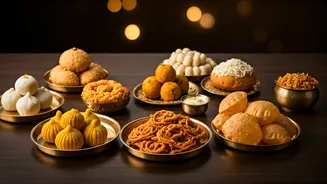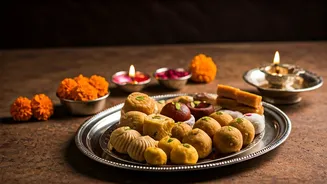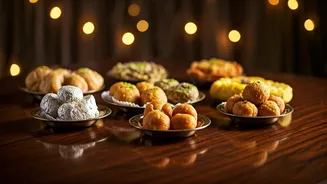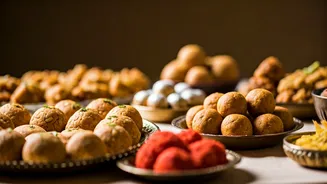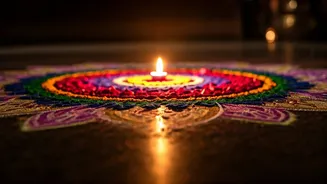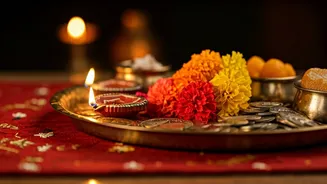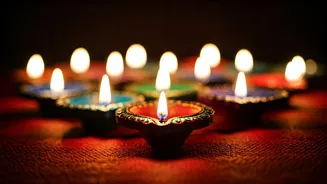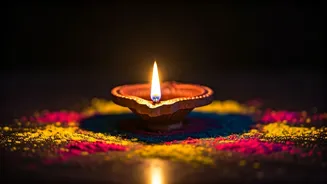Food Offerings' Significance
During Diwali, the act of offering food to deities is more than just a custom; it symbolizes gratitude, prosperity, and a connection with the divine. The
foods selected are not arbitrary; each carries a specific meaning and is believed to please the gods, thereby inviting their blessings. These offerings are usually prepared with great care, often using traditional recipes passed down through generations. These foods form a cornerstone of the Diwali rituals, transforming the occasion into a celebration of abundance and spirituality. They are not merely consumed; they are also shared with family and friends, reinforcing community bonds and spreading joy.
Ladoo: Sweet Beginnings
Ladoo, a round sweet typically made from gram flour (besan), sugar, and ghee, is a staple offering, especially dear to Lord Ganesha. Its spherical shape signifies completeness and the cyclical nature of life. The sweetness of the ladoo represents the joy and happiness that the gods bestow upon their devotees. Various types of ladoos, such as motichoor ladoo and besan ladoo, are prepared, each with its unique flavor and texture. The presence of ladoos on the offering platter signifies the auspicious beginning of new ventures and the sweetness of success and prosperity in one's life. The sharing of ladoos among family and friends also symbolizes the spreading of happiness.
Modak: Ganesha's Delight
Modak is a dumpling-shaped sweet that is particularly beloved by Lord Ganesha, often made with rice flour and stuffed with a mixture of coconut, jaggery, and dry fruits. The shape of the modak is believed to resemble Ganesha's head, making it a sacred offering. Modaks can be steamed or fried, and they represent knowledge and wisdom. Offering modaks is a way to seek Ganesha's blessings for the removal of obstacles and the attainment of knowledge. The offering of modaks is often accompanied by prayers for success and the fulfillment of desires, making it an integral part of the Diwali festivities and other important occasions.
Kheer: Rice Pudding
Kheer, a creamy rice pudding made with milk, sugar, and often garnished with nuts and cardamom, is a traditional offering associated with Goddess Lakshmi. The richness of kheer represents prosperity and abundance. Its white color symbolizes purity and peace. Making and offering kheer during Diwali is a way to invoke Goddess Lakshmi's blessings for wealth, health, and happiness. Kheer is prepared with various recipes that enhance its flavor, and its consumption is viewed as a means to invite good fortune and a joyous life. The offering of kheer symbolizes a wish for the well-being of the family and prosperity in all endeavors.
Puri & Halwa: Festive Duo
Puri, a deep-fried Indian bread, often paired with halwa, a sweet dish made from semolina, sugar, and ghee, forms a significant offering. Puri symbolizes the simplicity and purity of devotion, while halwa's sweetness represents the joy and prosperity one wishes to attract. This combination is common in various rituals and festivals, with variations in ingredients and preparation methods adding to its versatility. Offering puri and halwa during Diwali is seen as an act of hospitality towards the deities and a way to invite abundance into the home. Sharing them among family and friends reflects the communal aspect of the festival, reinforcing the bonds of love and unity.
Coconut: Symbolic Fruit
The coconut, or nariyal, is considered a sacred fruit in Hinduism, and it is a common offering during Diwali. The coconut symbolizes purity and represents the detachment from ego, as the hard shell encapsulates the soft, sweet flesh. It's often broken open before the deities as a gesture of surrendering oneself to the divine. This action indicates the offering of one's ego and desires to the gods, signifying a commitment to a life of devotion and service. The coconut is often presented to Goddess Lakshmi to seek blessings for prosperity and well-being, while its presence is deemed auspicious in many rituals and celebrations.
Paans: Betel Leaves
Paans, betel leaves filled with various ingredients like betel nut, catechu, and spices, are often offered after the puja. Paans symbolize satisfaction and the completion of rituals. The ingredients inside paan are believed to have digestive properties and are offered to deities after the meal. Offering paan is also a sign of respect and hospitality. Its consumption is considered auspicious, and it represents a satisfying conclusion to the festive meals and prayers. It is customary to offer paan to guests and family members after performing the Diwali rituals, indicating closure and well-wishes.
Dry Fruits: Nuts & Fruits
A mix of dry fruits, including almonds, cashews, raisins, and dates, is a popular offering. They symbolize wealth, health, and abundance. Dry fruits are rich in nutrients and are seen as offerings that provide energy and good health. Offering dry fruits to deities is a way to seek blessings for a prosperous and healthy life for all family members. They are often arranged on the offering platter, adding color and variety. These treats are also shared with family and friends to spread joy and good fortune. The practice symbolizes a wish for prosperity and well-being.
Fruits: Fresh Delights
Fresh fruits of various kinds are also offered during Diwali. They represent the fruits of one's labor, prosperity, and the sweetness of life. Different fruits are chosen based on their seasonality and availability, each carrying its significance. Mangoes, bananas, and pomegranates, for example, are common choices. Offering fresh fruits is a way of showing gratitude to the deities for their blessings. It also symbolizes health and vitality, and the freshness of the offerings represents the new beginnings and opportunities the festival of lights brings. The practice highlights the appreciation for life's bounty.
